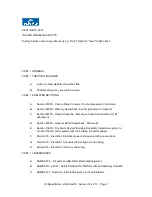
6.9 Transporting the occupied wheelchair in a
vehicle
Even when the wheelchair is properly secured and the
following rules are met, injuries to passengers may occur
in a collision or sudden stop. Therefore Invacare strongly
recommends transferring the wheelchair user to the vehicle
seat with the seat belt on. Do not make alterations or
substitutions to points of the wheelchair (structure, frame
or parts) without the written consent of Invacare. The
wheelchair has been successfully tested according to the
requirements of ISO 7176–19.
WARNING!
Risk of serious injury or death
To use the wheelchair as a seat in a vehicle the
backrest height must be at least 400 mm.
To transport the wheelchair with user in a vehicle, a
restraint system must be installed in the vehicle. Wheelchair
tie-downs and occupant restraint systems must be
approved according to ISO 10542-1. Contact your Invacare
representative or your provider for more information on
getting and installing an approved and compatible restraint
system.
WARNING!
If, for some reason, it is impossible to transfer the
wheelchair user to a vehicle seat, the wheelchair
can be used as a seat in a vehicle if the following
procedures and regulations are followed. A
transportation kit (optional) has to be fitted on
the wheelchair for such a purpose.
– The wheelchair must be secured in the vehicle
with a 4-point wheelchair restraint system.
– The user must wear a 3-point passenger
restraint system secured to the vehicle.
WARNING!
Safety restraint devices must only be used when
the wheelchair user's weight is 22 kg or more
(ISO-7176-19).
– Do not use the wheelchair as a seat in a vehicle
when the user weight is lower than 22 kg.
1659285-A
41
Summary of Contents for Compact FF
Page 59: ...Notes ...
















































